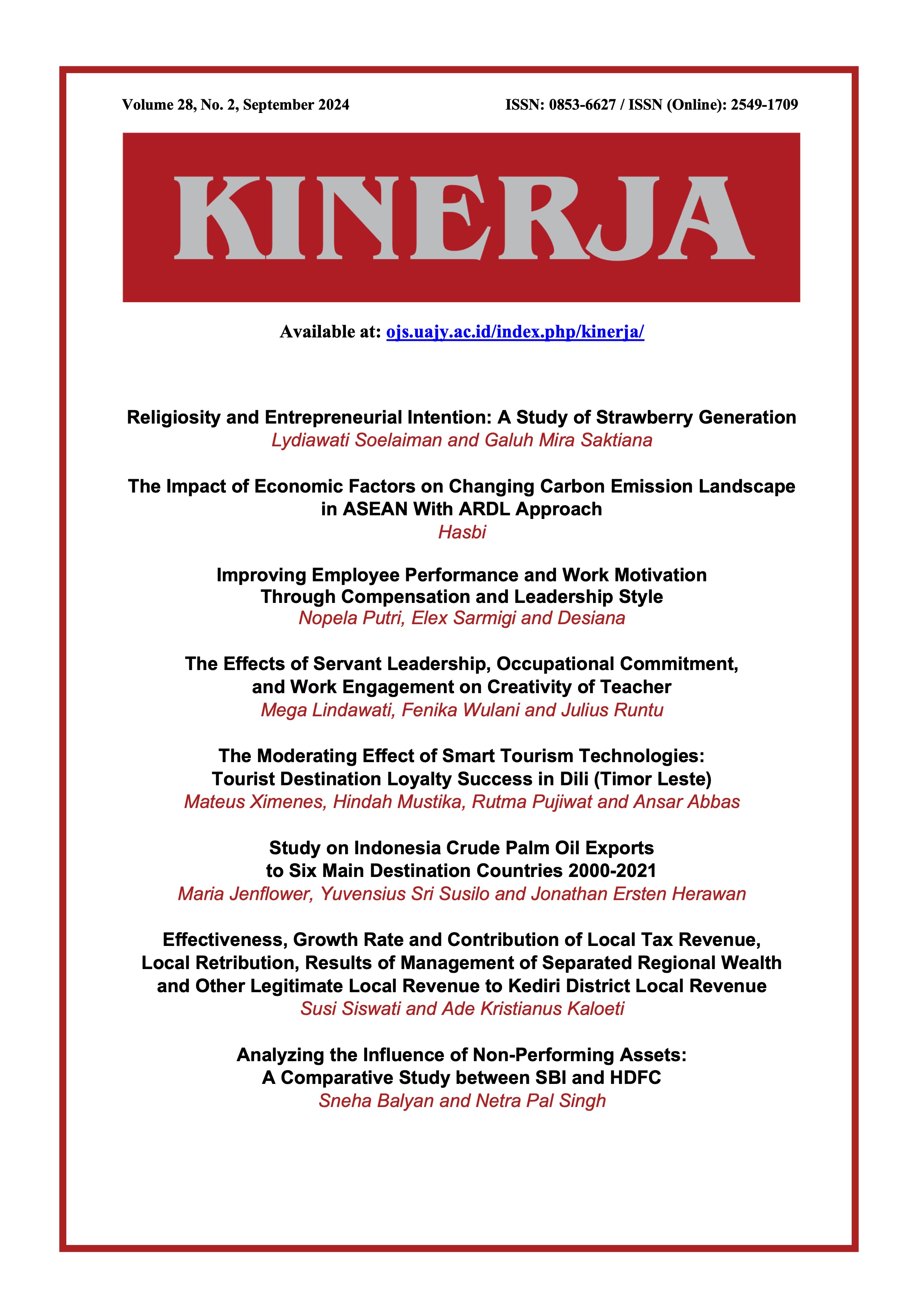The Impact of Economic Factors on Changing Carbon Emission Landscape in ASEAN With ARDL Approach
DOI:
https://doi.org/10.24002/kinerja.v28i2.8583Keywords:
carbon emissions, urbanization, foreign direct investment, population, economic growth, ASEANAbstract
This study aims to analyze the factors influencing carbon emissions in the member countries of the Association of Southeast Asian Nations (ASEAN). The data used in this study covers the period from 1990 to 2021, utilizing the Autoregressive Distributed Lag (ARDL) analysis method. All independent variables show a significant impact on carbon emissions in both the short and long term. This research provides evidence that factors such as urbanization, foreign direct investment, population, and economic growth significantly contribute to the increase in carbon emissions in ASEAN countries. The findings also validate the Environmental Kuznets Curve hypothesis for carbon emissions in ASEAN countries. In other words, economic growth leads to a reduction in carbon emissions. The ASEAN region has experienced substantial economic growth over the past few decades. However, carbon dioxide (CO2) remains a socio-economic issue in the ASEAN region. The results of this study can be highly beneficial for policymakers in the region regarding sustainability and economic development.
References
Abdouli, M., & Hammami, S., 2017. Investigating the causality links between environmental quality, foreign direct investment, and economic growth in MENA countries. International Business Review, 26(2), pp.264–278.
Adebayo, T. S., Agboola, M. O., Rjoub, H., Adeshola, I., Agyekum, E. B., & Kumar, N. M., 2021. Linking economic growth, urbanization, and environmental degradation in China: what is the role of hydroelectricity consumption? International Journal of Environmental Research and Public Health, 18(13), p.6975.
Afriye, D., Zhong, W., Shougeng, H., Ampofo, G. M. K., & Asante, D. A., 2022. Exploring the dynamic nexus between urbanization and economic growth with carbon emissions in sub-Saharan Africa: Evidence from panel PMG-ARDL estimation.
Ahmed, M., Khan, A. M., Bibi, S., & Zakaria, M., 2017. Convergence of per capita CO2 emissions across the globe: Insights via wavelet analysis. Renewable and Sustainable Energy Reviews, 75, pp.86–97.
Ali, H.S., Law, S.H. and Zannah, T.I., 2016. Dynamic impact of urbanization, economic growth, energy consumption, and trade openness on CO 2 emissions in Nigeria. Environmental Science and Pollution Research, 23, pp.12435-12443.
ASEAN, 2021. ASEAN Overview. Available at: https://asean.org/asean/about-asean/overview/
Behera, S. R., & Dash, D. P., 2017. The effect of urbanization, energy consumption, and foreign direct investment on the carbon dioxide emission in the SSEA (South and Southeast Asian) region. Renewable and Sustainable Energy Reviews, 70, pp.96–106.
Bieth, R. C. E., 2021. The influence of Gross Domestic Product and human development index on CO2 emissions. Journal of Physics: Conference Series, 1808(1), p.12034.
Birdsall, N., & Wheeler, D., 1993. Trade policy and industrial pollution in Latin America: where are the pollution havens? The Journal of Environment & Development, 2(1), pp.137–149.
Cole, M. A., & Neumayer, E. 2004. Examining the Impact of Demographic Factors on Air Pollution. Population and Environment, 26(1), pp.5–21.
Copeland, B. R., & Taylor, M. S., 1994. North-South trade and the environment. The Quarterly Journal of Economics, 109(3), pp.755–787.
Dietz, T., Rosa, E. A., & York, R., 2007. Driving the human ecological footprint. Frontiers in Ecology and the Environment, 5(1), pp.13–18.
Dong, B., Ma, X., Zhang, Z., Zhang, H., Chen, R., Song, Y., Shen, M., & Xiang, R., 2020. Carbon emissions, the industrial structure and economic growth: Evidence from heterogeneous industries in China. Environmental Pollution, 262, p.114322.
Ekwueme, D. C., Zoaka, J. D., & Alola, A. A., 2021. Carbon emission effect of renewable energy utilization, fiscal development, and foreign direct investment in South Africa. Environmental Science and Pollution Research, 28(31), pp.41821–41833.
Enders, W., 2014. Applied Econometric Time Series. "2th ed." New York (US): University of Alabama.
Engleman, R., 1994. Stabilizing the atmosphere: Population, consumption and carbon dioxide emissions. Population Action International, Washington DC.
Essandoh, O. K., Islam, M., & Kakinaka, M., 2020. Linking international trade and foreign direct investment to CO2 emissions: any differences between developed and developing countries? Science of the Total Environment, 712, p.136437.
Flamarz Al-Arkawazi, S. A., 2018. Measuring the Influences and Impacts of Signalized Intersection Delay Reduction on the Fuel Consumption, Operation Cost and Exhaust Emissions. Civil Engineering Journal, 4(3), p.552.
Frankel, J. A., & Romer, D., 1999. Does trade cause growth? American Economic Review, 89(3), pp.379–399.
Gujarati, D. N., & Porter, D. C., 2009. Basic Econometrics. New York: McGraw-hill.
Halliru, A. M., Loganathan, N., Golam Hassan, A. A., Mardani, A., & Kamyab, H., 2020. Re-examining the environmental kuznets curve hypothesis in the economic community of West African states: A panel quantile regression approach. Journal of Cleaner Production, 276, p.124247.
Hariani, E. T., Widyawati, R. F., & Ginting, A. L., 2022. Determinants of Carbon Emissions in 10 ASEAN Countries. Economics Development Analysis Journal, 11(3), pp.313–320.
Hassan, S. T., Xia, E., Khan, N. H., & Shah, S. M. A., 2019. Economic growth, natural resources, and ecological footprints: evidence from Pakistan. Environmental Science and Pollution Research, 26, pp.2929–2938.
Hewage, R. S., Othman, N., Pyeman, J., & Samad, N. S. A., 2022. Impact of Economic Growth, Financial Development and Technological Advancements on Carbon Emissions: Evidence from ASEAN Countries. IOP Conference Series: Earth and Environmental Science, 1102(1), p.12040.
Huang, Y., Chen, F., Wei, H., Xiang, J., Xu, Z., & Akram, R., 2022. The Impacts of FDI Inflows on Carbon Emissions: Economic Development and Regulatory Quality as Moderators. Frontiers in Energy Research, 9(January), pp.1–11.
Ismail, M. S., Moghavvemi, M., & Mahlia, T. M. I., 2013. Techno-economic analysis of an optimized photovoltaic and diesel generator hybrid power system for remote houses in a tropical climate. Energy Conversion and Management, 69, pp.163–173.
Jermsittiparsert, K., 2021. Does urbanization, industrialization, and income unequal distribution lead to environmental degradation? Fresh evidence from ASEAN. International Journal of Economics and Finance Studies, 13(2), pp.253–272.
Joshua, U., Bekun, F. V., & Sarkodie, S. A., 2020. New insight into the causal linkage between economic expansion, FDI, coal consumption, pollutant emissions and urbanization in South Africa. Environmental Science and Pollution Research, 27, pp.18013–18024.
Khan, Y. A., & Ahmad, M., 2021. Investigating the impact of renewable energy, international trade, tourism, and foreign direct investment on carbon emission in developing as well as developed countries. Environmental Science and Pollution Research, 28, pp.31246–31255.
Lawal, I. M., 2019. Impact of population growth on Carbon Dioxide (CO2) emission: empirical evidence from Nigeria. Jurnal Perspektif Pembiayaan Dan Pembangunan Daerah, 6(6), pp.701–708.
Li, K., Hu, E., Xu, C., Musah, M., Kong, Y., Mensah, I. A., Zu, J., Jiang, W., & Su, Y., 2021. A heterogeneous analysis of the nexus between energy consumption, economic growth and carbon emissions: Evidence from the Group of Twenty (G20) countries. Energy Exploration & Exploitation, 39(3), pp.815–837.
Lieu, P. T., & Ngoc, B. H., 2023. The relationship between economic diversification and carbon emissions in developing countries. International Journal of Applied Economics, Finance and Accounting, 15(1), pp.21–28.
Lisaba Jr, E. B. F., & Lopez, N. S. A., 2021. Spatiotemporal comparison of drivers to CO2 emissions in ASEAN: a decomposition study. Sustainability, 13(11), p.6183.
Luqman, M., Rayner, P. J., & Gurney, K. R., 2023. On the impact of urbanisation on CO2 emissions. NPJ Urban Sustainability, 3(1), p.6.
Mahadevan, R., & Sun, Y., 2020. Effects of foreign direct investment on carbon emissions: Evidence from China and its Belt and Road countries. Journal of Environmental Management, 276, p.111321.
Marquardt, J., 2016. How power shapes energy transitions in Southeast Asia: A complex governance challenge. Taylor & Francis.
Mikayilov, J. I., Galeotti, M., & Hasanov, F. J., 2018. The impact of economic growth on CO2 emissions in Azerbaijan. Journal of Cleaner Production, 197, pp.1558–1572.
Mofijur, M., Mahlia, T. M. I., Silitonga, A. S., Ong, H. C., Silakhori, M., Hasan, M. H., Putra, N., & Rahman, S. M. A., 2019. Phase change materials (PCM) for solar energy usages and storage: An overview. Energies, 12(16), p.3167.
Munir, Q., Lean, H.H. and Smyth, R., 2020. CO2 emissions, energy consumption and economic growth in the ASEAN-5 countries: A cross-sectional dependence approach. Energy Economics, 85, p.104571.
Nunti, C., Somboon, K., & Intapan, C., 2020. The impact of climate change on agriculture sector in ASEAN. Journal of Physics: Conference Series, 1651(1), p.12026.
Odugbesan, J. A., & Adebayo, T. S., 2020. The symmetrical and asymmetrical effects of foreign direct investment and financial development on carbon emission: evidence from Nigeria. SN Applied Sciences, 2(12), p.1982.
Odugbesan, J.A. and Rjoub, H., 2020. Relationship among economic growth, energy consumption, CO2 emission, and urbanization: evidence from MINT countries. Sage Open, 10(2), p.2158244020914648.
Omri, A., Nguyen, D. K., & Rault, C., 2014. Causal interactions between CO2 emissions, FDI, and economic growth: Evidence from dynamic simultaneous-equation models. Economic Modelling, 42, pp.382–389.
Opoku, E. E. O., & Boachie, M. K., 2020. The environmental impact of industrialization and foreign direct investment. Energy Policy, 137, p.111178.
Pata, U. K., 2018. Renewable energy consumption, urbanization, financial development, income and CO2 emissions in Turkey: Testing EKC hypothesis with structural breaks. Journal of Cleaner Production, 187, pp.770–779.
Perwithosuci, W., Hadibasyir, H. Z., & Arif, M., 2022. Carbon Emissions and Urbanization in ASEAN-5 Countries. Optimum: Jurnal Ekonomi Dan Pembangunan, 12(2), pp.203–212.
Pesaran, M. H., Shin, Y., & Smith, R. J., 2001. Bounds testing approaches to the analysis of level relationships. Journal of Applied Econometrics, 16(3), pp.289–326.
Pratama, A.S., Pudjihardjo, M., Manzilati, A. and Pratomo, D.S., 2021. Effect of Economic Growth, Industrialization, Population Growth, and Renewable Energy on CO2 Emissions in the Long and Short Term in ASEAN 5. Journal of Economics, Finance And Management Studies, 4(7), pp. 1149-1158.
Rahman, Z. U., Cai, H., & Ahmad, M., 2023. A new look at the remittances-FDI-energy-environment nexus in the case of selected Asian nations. The Singapore Economic Review, 68(01), pp.157–175.
Ridzuan, A. R., Noor, A. H. M., & Ahmed, E. M., 2014. the impact of foreign direct investment towards carbon dioxide level: pollution havens model for ASEAN5 countries. Asian Journal of Agricultural Extension, Economics & Sociology, 3(5), pp.392–404.
Rusiadi, R. H., & Subiantoro, N., 2014. Metode Penelitian Manajemen, Akuntansi dan Ekonomi Pembangunan (Konsep, Kasus dan Aplikasi SPSS, Eviews, Amos, Lisres). Medan: USU Press.
Saboori, B., & Sulaiman, J., 2013. CO2 emissions, energy consumption and economic growth in Association of Southeast Asian Nations (ASEAN) countries: A cointegration approach. Energy, 55, pp.813–822.
Salahuddin, M., Alam, K., Ozturk, I., & Sohag, K., 2018. The effects of electricity consumption, economic growth, financial development and foreign direct investment on CO2 emissions in Kuwait. Renewable and Sustainable Energy Reviews, 81, pp.2002–2010.
Schröder, E., & Storm, S., 2020. Economic growth and carbon emissions: The road to "hothouse earth" is paved with good intentions. International Journal of Political Economy, 49(2), pp.153–173.
Setyadharma, A., Nikensari, S. I., Oktavilia, S., & Wahyuningrum, I. F. S., 2021. The impacts of economic freedom on the environment: The case of carbon dioxide emissions in seven ASEAN countries. IOP Conference Series: Earth and Environmental Science, 896(1), p.12080.
Shahbaz, M., & Sinha, A., 2019. Environmental Kuznets curve for CO2 emissions: a literature survey. Journal of Economic Studies, 46(1), pp.106–168.
Sheraz, M., Deyi, X., Sinha, A., Mumtaz, M. Z., & Fatima, N., 2022. The dynamic nexus among financial development, renewable energy and carbon emissions: Moderating roles of globalization and institutional quality across BRI countries. Journal of Cleaner Production, 343, p.130995.
Shi, A., 2003. The impact of population pressure on global carbon dioxide emissions, 1975–1996: evidence from pooled cross-country data. Ecological Economics, 44(1), pp.29–42.
Silitonga, A. S., Mahlia, T. M. I., Ong, H. C., Riayatsyah, T. M. I., Kusumo, F., Ibrahim, H., Dharma, S., & Gumilang, D., 2017. A comparative study of biodiesel production methods for Reutealis trisperma biodiesel. Energy Sources, Part A: Recovery, Utilization, and Environmental Effects, 39(20), pp.2006–2014.
Suci Wulandari Siregar, H., 2023. Analisis Pengaruh Keterbukaan Perdagangan, Konsumsi Energi, Dan Pertumbuhan Ekonomi Terhadap Emisi Karbon Di Negara D-8. Jurnal Magister Ekonomi Syariah, 2(1 Juni), pp.61–77.
Thangaiyarkarasi, N., & Vanitha, S., 2021. The impact of financial development on decarbonization factors of carbon emissions: A global perspective. International Journal of Energy Economics and Policy, 11(6), pp.353–364.
Wang, Yanan, Zuo, Y., Li, W., Kang, Y., Chen, W., Zhao, M., & Chen, H., 2019. Does environmental regulation affect CO2 emissions? Analysis based on threshold effect model. Clean Technologies and Environmental Policy, 21(3), pp.565–577.
Wang, Yuan, Chen, L., & Kubota, J., 2016. The relationship between urbanization, energy use and carbon emissions: evidence from a panel of Association of Southeast Asian Nations (ASEAN) countries. Journal of Cleaner Production, 112, pp.1368–1374.
Widyawati, R. F., Hariani, E., Ginting, A. L., & Nainggolan, E., 2021. Pengaruh Pertumbuhan Ekonomi, Populasi Penduduk Kota, Keterbukaan Perdagangan Internasional Terhadap Emisi Gas Karbon Dioksida (CO2) Di Negara ASEAN. Jambura Agribusiness Journal, 3(1), pp.37–47.
World Health Organization, 2021. Climate Change and Health. Available at: https://www.who.int/news-room/fact-sheets/detail/climate-change-and-health
Yan, J., Dong, Q., Wu, Y., Yang, H., & Liu, X., 2023. The Impact of Urbanization on Carbon Emissions from Perspective of Residential Consumption. Polish Journal of Environmental Studies, 32(3).
Zafar, M. W., Zaidi, S. A. H., Khan, N. R., Mirza, F. M., Hou, F., & Kirmani, S. A. A., 2019. The impact of natural resources, human capital, and foreign direct investment on the ecological footprint: the case of the United States. Resources Policy, 63, p.101428.
Zhang, Jie, Fan, Z., Chen, Y., Gao, J., & Liu, W., 2020. Decomposition and decoupling analysis of carbon dioxide emissions from economic growth in the context of China and the ASEAN countries. Science of the Total Environment, 714, p.136649.
Zhang, Jihuan, 2021. Environmental Kuznets curve hypothesis on CO2 emissions: evidence for China. Journal of Risk and Financial Management, 14(3), p.93.
Zhu, H., Duan, L., Guo, Y., & Yu, K., 2016. The effects of FDI, economic growth and energy consumption on carbon emissions in ASEAN-5: evidence from panel quantile regression. Economic Modelling, 58, pp.237–248.
Downloads
Published
Issue
Section
License
Copyright (c) 2024 Hasbi Hasbi

This work is licensed under a Creative Commons Attribution 4.0 International License.















